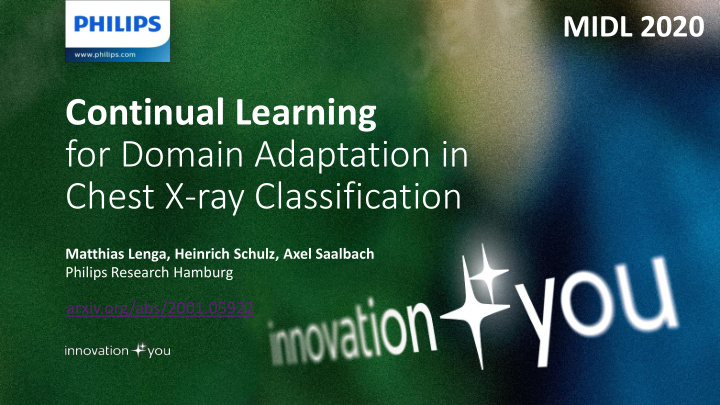



MIDL 2020 Continual Learning for Domain Adaptation in Chest X-ray Classification Matthias Lenga, Heinrich Schulz, Axel Saalbach Philips Research Hamburg arxiv.org/abs/2001.05922
Domain shift in CXR classification • For Chest X-ray classification DL performance is on par to radiologists [Majkowska et al., 2019] • Performance degradations were reported, when applied to data from a (unseen) target domain [Zhang et al., 2019; Yao et al., 2019] • Example: DenseNet121 (ChestX-ray14 MIMIC-CXR ) 0.86 0.77 mean AUC PTX: 0.88 0.76 mean AUC CMG: • Domain shift: Data distributions of source and target domain differ ChestX-ray14 model on ChestX-ray14 model on – hospital specific protocols ChestX-ray14 test dataset MIMIC-CXR test dataset – operator preferences – different scanners – changing class frequencies – errors in labelling
Continual Learning Studies the problem of learning from a stream of data : • Sequential learning process : Only small portion of input data from one (or a few) tasks is available at once • Gradually extend acquired knowledge • Learn without catastrophic forgetting : Preservation of certain model characteristics might be required due to regulatory considerations Source: [De Lange et. al, 2019]
Regularization-based CL for CXR classification • Feasibility study focusing on regularization-based methods EWC and LWF • These methods do not require any data from the source domain (e.g. containing sensitive PHI) EWC: Assumes a prior distribution on the network weights [Kirkpatrick et al., 2017] current task’s loss LL of prior (on NN weights) related to previous task (empirical Fisher matrix of LL related to previous task ) LWF: Adds soft-target regularization to training loss which reflects the behavior of the model associated to the previous task on current task data [Li and Hoiem, 2017] current task’s loss soft target regularization Model related to previous task (e.g. model trained on source domain)
Quantitative results: Forward & Backward Transfer Evaluation: Joint Training (JT) baseline vs. EWC vs. LWF • Setup: DenseNet121, ChestX-ray14 (source domain) MIMIC-CXR (target domain) • Mean AUC after adaption to targeted domain : JT- k% / EWC / LWF ≈ 0.82 • FTW: measures how good the model generalizes to target domain • BWT: measures model performance on source domain after adaptation to target domain [Lopez-Paz and Ranzato, 2017] k% of the data from source domain required No data from source domain required
Conclusion • Shifts in the distribution of medical image data across different sites – Pre-trained models are often not directly applicable as a result of performance degradations – On-site retraining desired but potentially constrained owing to regulatory guidelines • Investigated the applicability of different Continual Learning methods for domain adaptation in CXR classification – Adapt to target domain data – Preserve source domain performance (avoid “Catastrophic Forgetting”) • Selected ChestX-ray14 and MIMIC-CXR as distinct domains in order to simulate a realistic domain shift – Discussion of regularization based CL methods EWC and LWF – Continual learning without image / gradient / … information related to source domain (privacy compliant) • Quantitative evaluation : EWC vs. LWF vs. JT, measuring FWT and BWT • Continual Learning methods for Medical image classification: – Provide effective means in order to overcome performance degradations resulting from a domain shift – For ChestX-ray14/MIMIC-CXR a positive Backward Transfer was obtained using LWF (on average) arxiv.org/abs/2001.05922
Recommend
More recommend